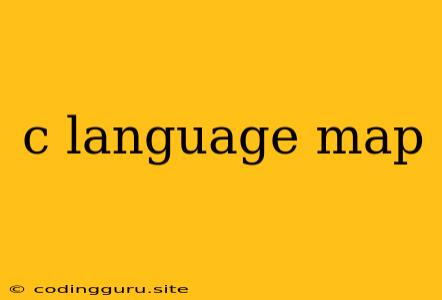Navigating the World of C Language Maps: A Comprehensive Guide
The C language is renowned for its power and efficiency, but it can be challenging to manage data structures efficiently. This is where maps, a powerful data structure, come into play. C language maps provide a way to store and retrieve data based on keys, making them incredibly useful for various applications.
But what exactly are C language maps? How do they work? And how can you implement them effectively?
Let's delve into the intricacies of C language maps, exploring their implementation, advantages, and applications.
What are C language maps?
C language maps are data structures that associate keys with corresponding values. Think of them like a real-life dictionary where you look up a word (the key) to find its definition (the value). In C, these key-value pairs are stored and accessed through efficient mechanisms, allowing for quick lookups and manipulations.
Why use C language maps?
C language maps offer numerous advantages over traditional arrays and linked lists:
- Efficient Key-Based Access: Maps allow you to retrieve values directly using their associated keys, leading to faster lookup operations.
- Dynamic Sizing: C language maps can grow or shrink dynamically as needed, unlike fixed-size arrays.
- Flexibility: Maps can store a wide variety of data types for both keys and values, providing versatility in your applications.
Implementing C language maps
C does not offer a built-in map data structure. Instead, you can implement maps using various techniques, each with its own trade-offs:
1. Using Hash Tables:
- A hash table is a commonly used method to implement maps in C.
- It utilizes a hash function to map keys to indices within an array.
- Collision handling strategies are essential to resolve situations where multiple keys map to the same index.
- Advantages: Fast access and search operations.
- Disadvantages: Potential collisions can impact performance.
2. Using Balanced Binary Search Trees (BSTs):
- A BST is another popular choice for implementing maps.
- It maintains a sorted structure where keys are arranged in a hierarchical manner.
- Advantages: Efficient searching, insertion, and deletion operations, and automatic balancing helps maintain performance.
- Disadvantages: Can be more complex to implement than hash tables.
3. Using External Libraries:
- C libraries like glib provide ready-made map implementations.
- These libraries offer features like automatic memory management and robust error handling.
- Advantages: Simplify map implementation, providing pre-optimized solutions.
- Disadvantages: Adds dependency on external libraries.
Example: Implementing a C language map using a Hash Table
#include
#include
// Define a structure for key-value pairs
typedef struct Node {
int key;
char *value;
struct Node *next;
} Node;
// Define a structure for the hash table
typedef struct HashMap {
Node **table;
int size;
} HashMap;
// Hash function (using modulo operation)
int hash(int key, int size) {
return key % size;
}
// Create a new hash table
HashMap* createHashMap(int size) {
HashMap *map = (HashMap*)malloc(sizeof(HashMap));
map->size = size;
map->table = (Node**)malloc(sizeof(Node*) * size);
for (int i = 0; i < size; i++) {
map->table[i] = NULL;
}
return map;
}
// Insert a key-value pair into the hash table
void insert(HashMap *map, int key, char *value) {
int index = hash(key, map->size);
Node *newNode = (Node*)malloc(sizeof(Node));
newNode->key = key;
newNode->value = value;
newNode->next = map->table[index];
map->table[index] = newNode;
}
// Retrieve a value associated with a key
char* get(HashMap *map, int key) {
int index = hash(key, map->size);
Node *current = map->table[index];
while (current != NULL) {
if (current->key == key) {
return current->value;
}
current = current->next;
}
return NULL;
}
int main() {
// Create a hash table with a size of 10
HashMap *map = createHashMap(10);
// Insert key-value pairs
insert(map, 1, "Apple");
insert(map, 2, "Banana");
insert(map, 3, "Cherry");
// Retrieve values
printf("Value for key 2: %s\n", get(map, 2)); // Output: Banana
printf("Value for key 4: %s\n", get(map, 4)); // Output: (null)
return 0;
}
Applications of C language maps
C language maps are essential for various applications:
- Dictionaries and Databases: Store and retrieve data efficiently, enabling fast lookup operations.
- Caching: Cache frequently accessed data for faster retrieval.
- Symbol Tables: Map identifiers to their corresponding data in compilers and interpreters.
- Game Development: Manage game objects, player statistics, and in-game data.
- Network Programming: Store network connection information and map IP addresses to hostnames.
Conclusion
C language maps are powerful data structures that offer efficient key-based access, dynamic sizing, and versatility. By choosing the right implementation approach, you can harness their benefits for your C programs. Whether you use hash tables, balanced BSTs, or external libraries, mastering the use of maps is crucial for building effective and efficient C applications.
Remember, the choice of implementation depends on your specific needs and the type of data you're handling. By understanding the concepts and advantages of C language maps, you'll be better equipped to handle complex data structures and build robust software.
